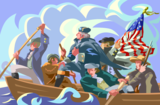
A great virtual plan for students to learn more about the events and people that lead to the American Revolution.
- Subject:
- History
- Material Type:
- Interactive
- Author:
- Rachel
- Date Added:
- 02/23/2022

A great virtual plan for students to learn more about the events and people that lead to the American Revolution.

Following a victory at the Battle of Trenton on December 26, General Washington and his army moved north to Princeton, New Jersey on January 3, 1777, where they surprised the British forces. This resource provides a background on the battle and how it changed the course of the American Revolution.

The Battle of Trenton was a pivotal moment in the American Revolution. At that time, the British had a chain of towns firmly under their control. This, coupled with the fact that many of Washington's soldiers' enlistments were about to expire on New Year's Day, forced Washington to make a bold plan. The Americans crossed the Delaware River on December 25, 1776 and attack Trenton the following day. Over a ten-hour period, 2,400 soldiers, 18 cannon and 100 horses crossed the frigid waters on ferries from Pennsylvania to New Jersey. This resource provides a background on the Battle and how it changed the course of the American Revolution.

All-in-one virtual map to show the events, people, and themes of the American revolution. Students can explore using the map or timeline. Or they can learn about themes of the war including: Slavery, Loyalist vs Patriots, Native American perspectives, or foreign aid.

Students would learn in the shoes and place of the American Revolution as well asking themselves questions of what is in place. The image is created by Jasmine Hall through Canva.

Take a closer look at news stories from the American Revolution and the early years of the republic. Let’s explore together: What techniques did journalists use to sway public opinion for or against the British? How did their personal opinions about politics affect how they reported on issues facing the new nation?
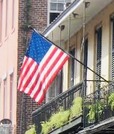
In this American Symbols unit, students will learn information about American symbols. Students will learn about various American Symbols such as the American Flag, the Liberty Bell, the Statue of Liberty, the Bald Eagle, and the White House. Students should then be able to draw a picture and write one fact about an American symbol. American Flag © 2024 by LeAnn Schmidt is licensed under CC BY-NC-SA 4.0

Advancements in transportation have played a key role in the growth of our nation. U.S.government policies have also had a considerable impact on the development of transport as we know it today. In this series of three lessons,the students examine transportation and its impact on our nation (and vice versa) since the United States declared its independence in 1776.
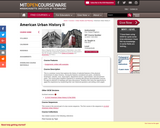
This is a seminar course that explores the history of selected features of the physical environment of urban America. Among the features considered are parks, cemeteries, tenements, suburbs, zoos, skyscrapers, department stores, supermarkets, and amusement parks. The course gives students experience in working with primary documentation sources through its selection of readings and class discussions. Students then have the opportunity to apply this experience by researching their own historical questions and writing a term paper.
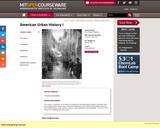
This course is a seminar on the history of institutions and institutional change in American cities from roughly 1850 to the present. Among the institutions to be looked at are political machines, police departments, courts, schools, prisons, public authorities, and universities. The focus of the course is on readings and discussions.

This is a large pdf unit designed to have students explore the ever changing and comples roles women played during WW1. Cross curricular--supports literacy standards.

The American Yawp constructs a coherent and accessible narrative from all the best of recent historical scholarship. Without losing sight of politics and power, it incorporates transnational perspectives, integrates diverse voices, recovers narratives of resistance, and explores the complex process of cultural creation. It looks for America in crowded slave cabins, bustling markets, congested tenements, and marbled halls. It navigates between maternity wards, prisons, streets, bars, and boardrooms. Whitman’s America, like ours, cut across the narrow boundaries that strangle many narratives. Balancing academic rigor with popular readability, The American Yawp offers a multi-layered, democratic alternative to the American past.

Students match posters, photos, and documents with the ways in which Americans were asked to contribute to the war effort during WW1.
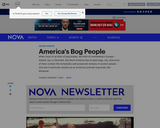
Article from NOVA on "America's Bog People".
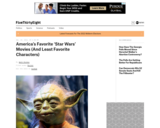
An article based on data and evidence that includes charts and infomation that could be analyzed by students.

This reading provides information regarding wealthy businessmen of the late 19th century and their roles as robber barons and/or captains of industry. It specifically reviews John D. Rockefeller and Andrew Carnegie.

his lesson uses music and art in a vocabulary study of unfamiliar words from the song "America the Beautiful," increasing students' vocabulary while also increasing their knowledge of U.S. geography. A discussion to activate students' prior knowledge about sights and scenery throughout the United States is followed by a read-aloud and introduction to the song "America the Beautiful," which is then sung in each session of the lesson. Students learn the meanings of the song's words through shared reading and the use of context clues and images. Students then use photographs, illustrations, and descriptive language to create a mural shaped like the United States. Finally, through pictures and words, students reflect on what they have learned. This lesson is appropriate and adaptable for any patriotic event or holiday, and many of the vocabulary strategies are adaptable for other texts or word lists, as well.

This patriotic song for kids is about America and I wrote this song from direct responses from children across the United States and what they told me this country means to them. Celebrate our United States of America as we sing about all the things that make this country great and what makes us proud to live in the United States of America. This song is a great song to celebrate the 4th of July, Independence Day, Memorial Day, President's Day or everyday we are able to celebrate our country and freedom.
Lyrics
When I think about America
I think of so many things
It's my country the United States
And it means so much to me
Green, green forests
Green, green forests
Having nice schools
Having nice schools
Voting for the president
Voting for the president
Red, white and blue
Red, white and blue
Playing in my neighborhood
Playing in my neighborhood
Believing in dreams
Believing in dreams
This is America to me
Celebrating holidays
Celebrating holidays
Pledge to our flag
Pledge to our flag
Great big mountains
Great big mountains
Learning all you can
Learning all you can
All different colors
All different colors
Being what you want to be
Being what you want to be
This is America to me
This is America, land that I love
My country the United States
Under one shining sun
So many different people
Together proud and free
This is America
America to me
All kinds of ice cream
All kinds of ice cream
Animals on farms
Animals on farms
Families at Thanksgiving
Families at Thanksgiving
Boats, trains and cars
Boats, trains and cars
Helping each other
Helping each other
People I love
People I love
This is America to me
This is America, land that I love
My country the United States
Under one shining sun
So many different people
Together proud and free
This is America
America to me
This is America, land that I love
My country the United States
Under one shining sun
So many different people
Together proud and free
This is America
America to me
This is America
America to me
Jack Hartmann's website: www.jackhartmann.com
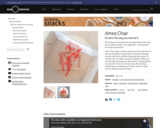
Short pieces of chenille stem arranged inside a box look like a random jumble of line segments—until viewed in the proper perspective.
Note: This activity is detail oriented and time intensive. It’s done by threading a long length of fishing line through twenty small holes, and then attaching short pieces of chenille stem to create a suspended pattern. When you look through a viewing hole, that random-looking pattern resolves into the form of a chair. If you think being a watchmaker is something you’d hate, then you might want to rethink doing this Snack!

Sikes, a popular social reformer in his day, worked with church groups and supported the efforts of the Working Women's Protective Union. First published in Putnam's Magazine, April 1868.